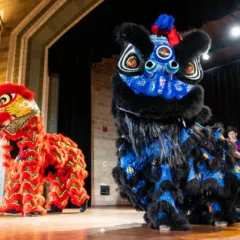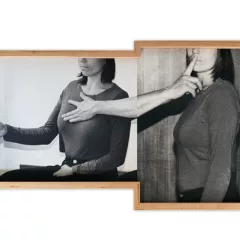Exhibition catalogs often include an interview with the artist along with an in-depth essay or two. Of course there’s also those glossy color plates like eye candy — all of which makes these documentary books fabulous to look at and read and useful in extending the life of the show. Two recent catalogs (and one show brochure ) that do the Q&A well are the ICA’s slim, notebook-like volume, “Mineral Spirits,” for the Anne Chu and Matthew Monahan exhibit (closing Sunday, Dec. 5); “Thomas Nozkowski,” the catalog for the artist’s exhibit at Pace (closing Saturday, Dec. 4); and “Paul Cava Thirty Years,” a four-fold brochure for Cava’s retrospective at Rosenwald-Wolf Gallery (extended to Dec. 7). All three of the exhibits are still up and definitely worth a visit.
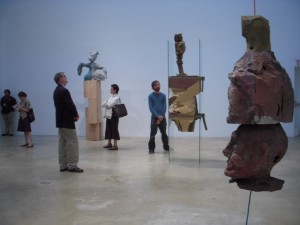
“Mineral Spirits” the two-person show at ICA featuring sculpture by Anne Chu and sculpture and drawings by Matthew Monathan has a little book that’s an extended Q&A between the artists and the show’s organizer, Curator Jenelle Porter.
After several pages devoted to defense of figurative art (both artists are in the statuary tradition) these two tidbits are unearthed — Monahan loves Flemish primitives like Grunwald, Jan van Eyck, Durer, Bosch and Breughel. And, he finds it hard to make hands and arms — very good information when looking at any sculpture, actually.
But then, talking about pedestals, Monahan, who is a sparky guy in this trialog, erupts with a small essay on sculpture’s place in the world — and art’s place in the world. It’s worth the price of the book. Art is this special thing, Monahan says. It’s not going to change the world…and please, he continues, let’s have fewer installations.
(P. 17) Monahan …For a long time it seemed like the goal of sculpture was that it would dissolve into the expanded field, that it would take on architecture, it would take on the great outdoors, and then it would have to take on politics once it got outside. It had to go ahead and change the world. But there is something about the pedestal that’s about framing, that’s saying, “Look, I’m just taking care of my little corner of shit here, and don’t bother me.” It’s a closing off, it’s definitely a shutting down; it’s a retraction.
Chu Well, that’s a presentation.
Monahan It’s a presentation, but it’s also saying, “Look, art is a special little zone here, and it’s not going to try to be anything else.” We’re not trying to envelop you in an installation experience. So in that way, it’s quite regressive. I’m speaking personally. I’m tired of this thing of art wrapping around me. I’m tired of the immersive experience. I’m tired of wondering if something is art or not. These were all things that were celebrated during my education. And I’m saying no, it’s art. The only place in the world this can survive is in art, and that’s a very special place in the world. We’re going to give some respect to art, which is very contradictory, very much against most of what I was taught. It’s precious, it’s fetishistic, it’s the return of the autonomous–all of that stuff. It’s the commodity. it’s all these bad things.
Chu It’s an object.
Monahan Well it’s not even an object; it’s art, which is a different, higher form than an object.
Later on Monahan again cuts through a wall of words and spits what he actually is after in his work. He talks about his relationship to the art market and the canon. Tres interesant.
(P. 21) Monahan Tragic poetry. That’s what I’m after. I want it to feel like some of my favorite songs. I want to look at it and have that feeling that some of my favorite songs can have: heartbreak, memory, mortality, life force…..I feel sometimes I should be harder, cooler. I could iron out some of the emotional qualities in my work, and the sentimentality. But then I think maybe I’d rather have a short-term buzz than try to hammer out my idiosyncrasies to fit into the canon.
Porter It would be paralyzing to try to make work that would fit the canon, whatever that might be.
Monahan Yes, but you walk this way and that. You know there are moves you can make in your work. There are things you could do, directions you could take. I think I’ll just stay in this ghetto for a bit, and that’s where I’ll find my truths.
Mineral Spirits
Anne Chu and Matthew Monahan in conversation with Curator Jenelle Porter
ICA Philadelphia
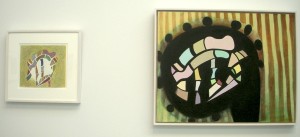
Thomas Nozkowski, maker of life-inspired abstractions, each one of which is like a delicious Rubik’s cube on the wall, exercises his Zen muscle in talking with Garth Lewis, whom he’s known for many years. One of the best passages in a very readable and relatively short Q&A has the artist talking about having made work for 35 years.
Nozkowski …The hardest thing I have ever had to do as an artist is to become an old one. I actually know how to make a Nozkowski now, and that can be a real trap.
Other chunks of information imparted include that the artist early on decided to work small, and on canvas board (a hated support in the art world); and that he was making work to hang on his friends’ apartment walls. In the 1970s he dabbled in sculpture–artfully arranged scavenged stuff on the floor (one image suggests they looked like a Nozkowski painting but made with gravel, clay, cloth, glass and other material). People loved the sculpture and thought he had embraced the “Painting is Dead” movement, which was prevalent at the time (he hadn’t). He was back to painting in short order.
Thomas Nozkowski
In conversation with Garth Lewis
Pace Gallery
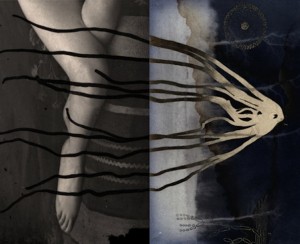
The 4-fold brochure accompanying Paul Cava’s retrospective at Rosenwald-Wolf Gallery (extended to Dec. 7) is not a catalog per se but with 12 color images and a wonderful Q&A between Cava and Curator Sid Sachs, the piece is comprehensive as a book. Loaded with history of the Philadelphia art scene, which Cava and Sachs have played major roles in for thirty or more years, the piece susses out the underpinnings of the artist’s sexy and poetic works.
Cava is trained as a photographer (he went to Rochester Institute of Technology) but his first art experience, was poetry, he says. While in college in New York in the 70s he headed up the student literary magazine and went to Soho openings where he and his buddies handed out poems from their publication.
Cava arrived in Philadelphia — which Sachs calls “a hard art city” — in 1975. After waiting tables at The Commissary restaurant he goes to Paris and studies up on early French photography, comes home to find a promised job at the PMA is a fiction, and finally, goes on to establish a gallery, which he funds through sales of a cache of antique French Barbizon photos found in an antique show on Strawberry St.
It’s a pithy interview, with Sachs’ questions including lots of details and Cava’s answers likewise. We learn that Cava was photographer Jock Sturges‘ first dealer. And we are reminded (those of us who remember Cava’s gallery spaces in Old City and Walnut St. the 80s and 90s) that he had a great gallery that showed Thomas Nozkowski, Ray Metzger, Neyssa Grassi, Francesco Clemente, Sharon Horvath, Susan Fenton, Steven Baris and a host of others. Cava takes photographs as well as appropriating found imagery. One of his favorite subjects is his wife, Devise Aveyou. Sachs brings up Denise in one question then asks, obviously referring to a similar relationship between another husband and wife/muse, “How does it feel to be Philadelphia’s Stieglitz?” It’s a great comparison.
Sachs hits a nerve when he asks whether Cava’s work, with its use of antique source material, is anomalous and out of its time. It’s a great exchange and the artist gets the last word and what he says is very fine.
Sachs…Each part of your process evokes the past. So here you are in the twenty-first century. How do you fit into your time? Do you feel somehow part of an anomalous parallel world?
Cava I understand the gist of your question but I feel you are stacking the deck a bit, for example, in the ink series I paint over other contemporary subjects besides old master paintings. There are the images of the victims of the Khmer Rouge and the Model and Man/Woman series, hardly romantic or nostalgic. In any case, I will cede your example for the sake of the larger point that you are making. I may use elements of the old in my work but seek in relation to other pictorial elements, a timelessness and most importantly an intimacy through metaphor. that is what I feel gives the work relevance and engages it in the here and now. I go for an unnerving sensual experience not for a nostalgic comfort zone. My concept of time is inclusive of the past but with a pulse. I often ground my work in natural forms because they are outside of specific culture and universal. Upon this ground I try to portray the humanist condition of being alive in a world where fear,love, anxiety, desire, and loss cross fertilize. It’s a sexy, messy business but someone has to do it, right?
Paul Cava Thirty Years
Paul Cava in conversation with Sid Sachs
Rosenwald-Wolf Gallery


